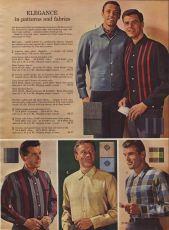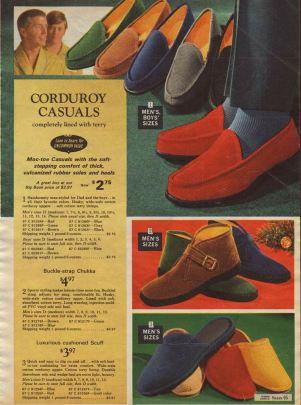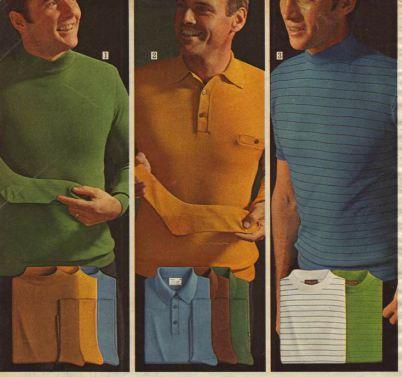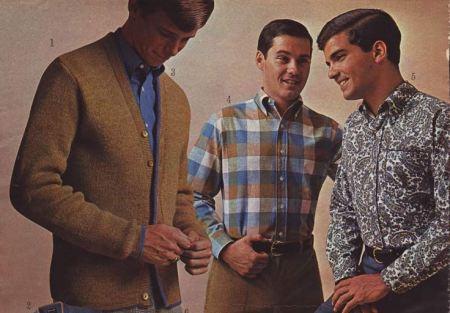The second part of the 20th century was a period of time ruled by duality in fashion and culture. On the one hand, there was the “norm”, the conservative style promoted by the mainstream media, and on the other hand there were the “rebels”, which, unlike the rebels of the years that had gone by, were not dressing according to the “rules”. The 1960s, 70s, and 80s were decades in which cultures clashed and co-existed at the same time.
The 1960s were probably one of the most contrasting times, as the new ways of expression were just starting to emerge and, if you think about it, they came as a shock. It was the first time when boys grew their hair long, people started wearing alternative clothes and act in a different manner than society asked of them. In the 1970s, they had seen it before, but in the 60s it was all new.
Designers and brands adapted quickly to the changes and offered clothes that were suited for all audiences: the mainstream fashion of the 1960s was a mix between a conservative look and a hippie look. Of course, the hippies accessorized and mixed their clothes to make them more suited for their vision and style, while conservatives toned them down.
The beginning of the 1960s was nothing like the end of it: while the first years were more reminiscent of the stoic 1950s, the last years of the decade stand today as the expression of “flower-power” and all things hippie. The counter-culture had finally become mainstream.
It was a time when women wore extremely short skirts and men wore tunics and capes. The center of the fashion world had moved for the first time in a lot of decades from Paris to London, the city that was now the center of all things fashion. And fashion, as we always like to say, does not limit itself to clothes, accessories and grooming, it is also metafashion: music, objects and attitudes are all related to the way one looks and feels.
During the 1960s, fashions changed for both men and women. Probably the most noticeable thing that changed, after the long hair, on the male style scene were the pants. These became much, much higher. The new pants were not as what men were used to: if by then pants were quite relaxed, the new pants had a sporty fit around the thigh.
Another thing that became popular during the mid-60s were pea coats. Men used to wear these with boots and hats, especially if they had the popular “London” look. By the end of the 60s, silk scarves were highly stylish, they almost replaced ties and were seen everywhere.
The 1960s developed a quite feminized male ideal. If you look not only at the clothes, but also at the poses and the models, you will see that the ideal man of the 1960s had traits that we today would associate with femininity. This is not good or bad, it simply is something that was a characteristic of the time. At the end of the decade, men’s pants became flared at the bottom. They resembled women’s pants very much, even though in fact it might be better to say that the lines between women’s clothes and men’s clothes became quite blurry.
In 1968, men used to match and mix fabrics, styles and accessories, making men’s fashion very fancy and colorful. Tailored suits, turtlenecks, Nehru jackets and jeans became very fashionable during this time as well.
Fashion houses realized that they could no longer do what they had been doing so they redesigned their concepts, turning fashion into something more mainstream and more appealing to the masses.
We have put together a collection of found images representing clothing ads from the 1960s. These serve as great resources for us if we want to analyze the social norms and the culture of the Western world during the 1960s.

















Studying these images now, we see a lot of interesting things that captured the spirit of the era. First of all, it’s funny how to us, most of these clothes, especially the buttoned sweaters remind us of the grandpa sweater. Of course, some styles are timeless and a few looks from the 60s are just as elegant today as they were back then! Each decade has created new icons that are so strong that they become archetypes.
Speaking of age, it is interesting to notice how these clothes for the average man (not teens or children) were addressed to quite older men, unlike the clothes today which are always showcased on very young models.
The clothes had that 1960s matchy-matchy vibe and were quite settled in presentation. However, we know that everyone used these clothes as they wishes: they either wore them as they were or they mixed them up according to their style and preferences.
It’s interesting to see how the models were mostly white and showed an appeal for certain traits, such as big teeth, wavy hair and big eyes. People of other races than Caucasians were almost invisible and rarely featured. However, when they were featured, they were mostly featured in ads concerning a younger audience, who, according to the advertisers, was probably more open to connecting with people of other ethnicities.
Overall, the 1960s were a great time for growth and development. The new aesthetics came as a shock for the fashion world but they rapidly became the voice of a movement. Having said that, we need to say that we are happy that the 60s are gone: while they are a great source of inspiration, today’s fashion seems a lot more subtle, more elegant and it seems to be heading to a more open vision of the world.
Fraquoh and Franchomme
P.S. What do you think about the mainstream fashion of the 60s? Which pieces would you like to wear? Do you own any vintage items from that time? Share your questions, feedback or comments below! Don’t forget that you can also follow us via e-mail or on our social media!
Share on Tumblr0
